A Salvaged Banksy Mural is Now on View in NYC
This unique Banksy mural goes up for auction on May 21st in NYC!


Originally, the now-buried Tibbetts Brook wound its way across the undeveloped land of the Bronx and into the Harlem River. Along the way, water would seep into lowland marshes, nourishing the diverse array of plants and fish. Nowadays, the stream, a possible source of clean water, is redirected underground. To raise awareness of this lost waterway, the group, City as a Living Laboratory (CALL), founded by artist Mary Miss, is developing a mobile wetlands for the project Daylighting Tibbetts Brook. The project aims to merge art and environmental activism in an ultimate effort to garner support for revitalizing crucial components of Bronx Wetlands.
Recently, a launch event was held in Van Cortlandt Park, where contributors of the project spoke about their vision and gave attendees a preview of the two art pieces that make up the project: the pop-up wetland Finding Tibbetts and Bob Braine’s accompanying project Estuary Tattoos. The two interactive pieces were created to advocate for the process of daylighting Tibbetts Brook, a process that would bring the subterranean water source above the ground level to reduce water pollution and enhance the ecosystem. Negotiations for advancing the daylighting of the stream are moving forward, and in order to maintain enthusiasm about the project, CALL will be traveling around the Bronx along the daylighting path with the aforementioned art projects beginning in September.
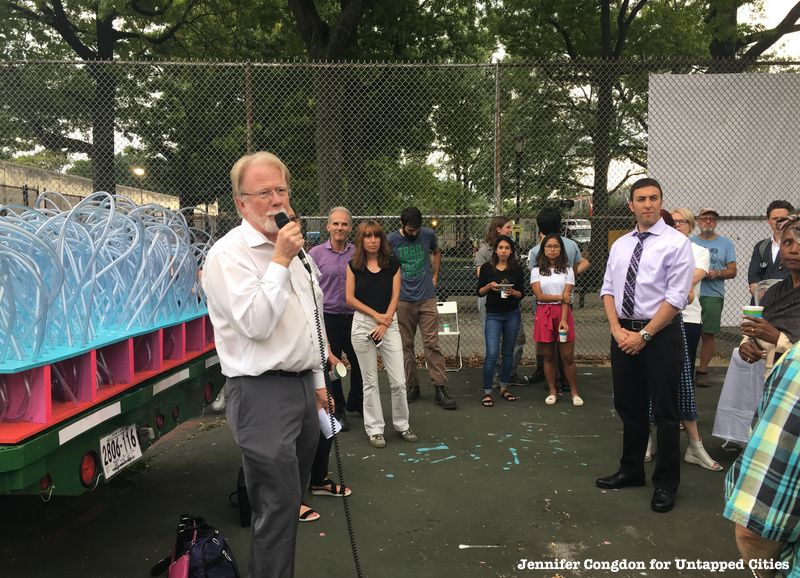
CALL Chairman Charles McKinney introducing the project
Underground, Tibbets Brook flows into New York City’s sewer system, which periodically causes flooding and combined sewer overflows. Most obviously, the flooding of sewage water is an issue that threatens the quality of life for residents in the Marble Hill and the Van Cortlandt Park area. But more overlooked is the fact that without the stream being above ground, the health of the landscape declines and biodiversity plummets. The process of daylighting Tibbetts Brook, as proposed by the NYC Parks Department, would bring the stream of water to the surface to combat these issues.
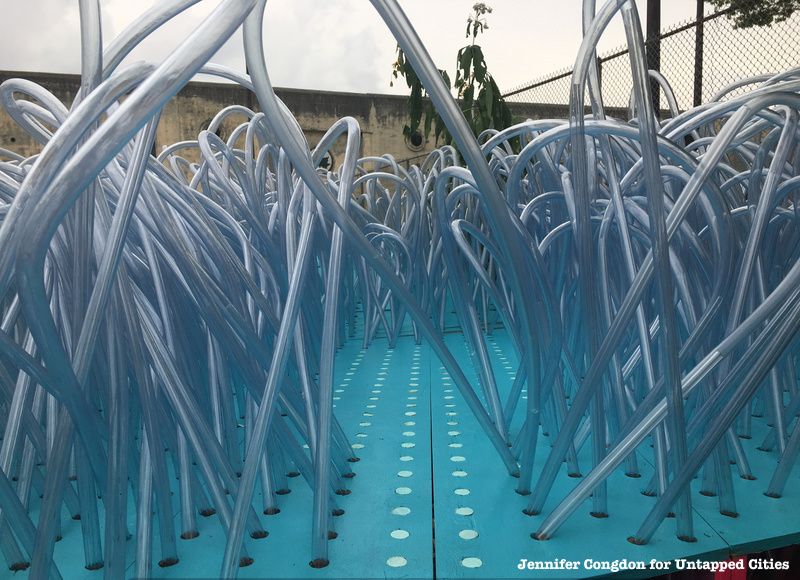
Inhabitable section of ‘Finding Tibbetts’
That being said, Amanda Schachter of SLO Architecture, the firm which created the Finding Tibbetts mobile wetland art piece, emphasizes that the process of reviving Tibbetts Brook is not about reducing development or attempting to restore the landscape to its original form. Rather, daylighting the brook is meant to allow the natural environment and the built environment to exist harmoniously, a combination that prioritizes the well-being of the city’s population. The plan is for Tibbetts Brook to run along the abandoned CSX railroad line and ending in the Harlem River. A successful case study can be found just nearby in the city of Yonkers, which has working on been daylighting the Saw Mill River for the last decade.
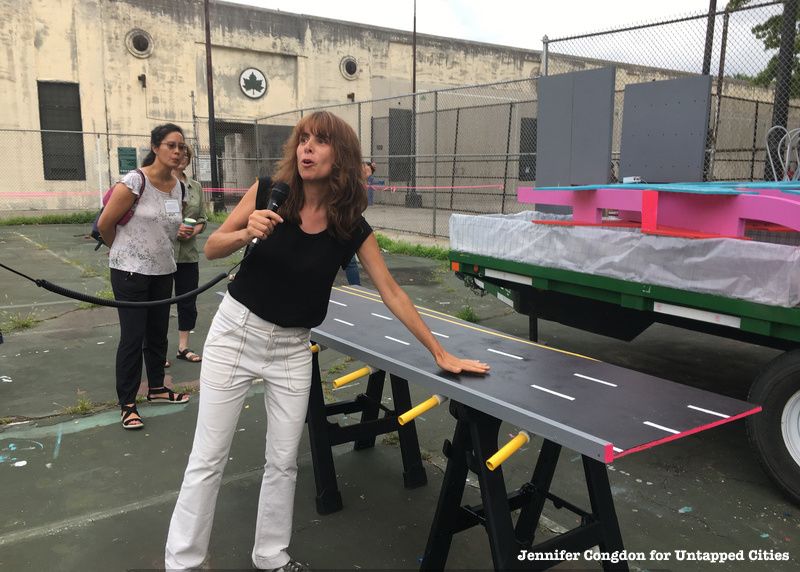
SLO Architecture’s Amanda Schachter describing a component of the ‘Finding Tibbetts’ Piece

Tube detail of ‘Finding Tibbetts’
In essence, Finding Tibbetts is an interactive installation piece consisting of a cross section of Tibbetts Brook. The aim of the piece is to prompt viewers to envision what unearthing Tibbetts Brook would look and feel like. The piece, designed by the aforementioned SLO Architecture, consists of a model landscape built upon a 8-foot-by-16-foot trailer bed. The piece is covered in winding tubes, in which water will course through, an artistic vision meant to magnify the water flow of Tibbetts Brook, next to a section made out of real marsh. Notably, the empty space that runs through the display makes it inhabitable; the main element of Finding Tibbetts is that viewers can actually climb inside the display and envision their own role in environmental activism.
A second portion of the piece, as pictured above, is a model consisting of a section of a highway with tubes on the side. This portion visualizes how the daylighted Tibbetts Brook is designed to work with the built environment. The idea is that water will run off of the impermeable surface of the highway and the tubes will pour the water into surrounding wetland.
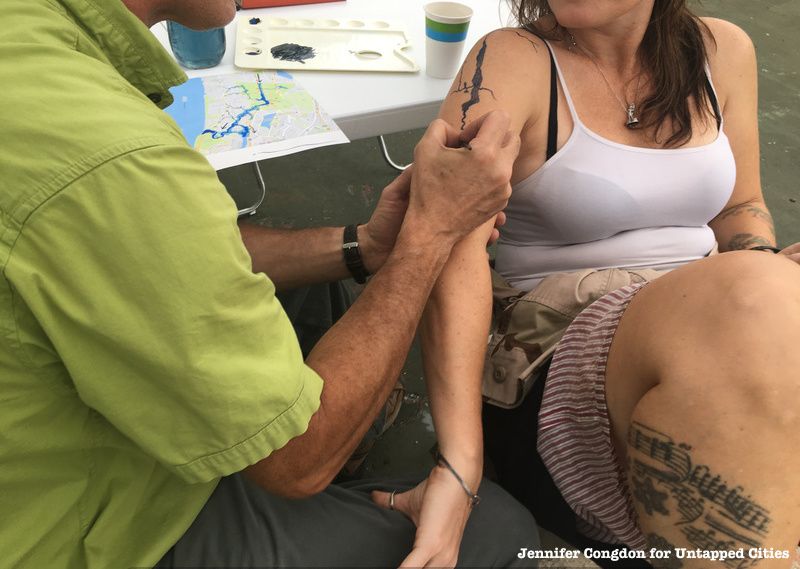
Artist Bob Braine’s ‘Estuary Tattoos’ project in action
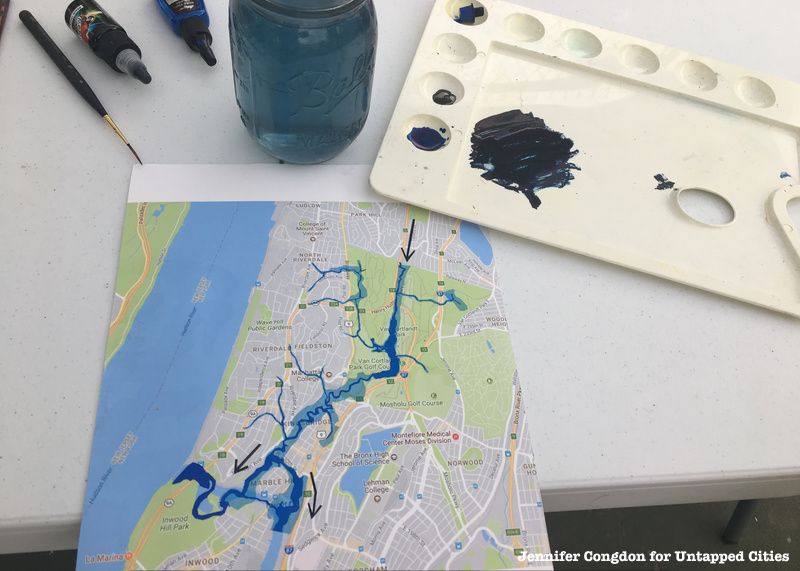
Bob Braine’s workstation with a map of the Bronx Wetlands
The second art component is artist Bob Braine’s project titled Estuary Tattoos, in which he uses tattoo ink as body paint to map the history of the Bronx Wetlands on participants’ bodies. Braine described his vision of combining and relating the way in which water flows through the landscape and the human body’s own circulatory system. Braine wishes for participants to form their own connections to the landscape and view themselves as a part of it, and therefore, able to change it, hopefully for the good.
A huge theme underlying the Daylighting Tibbetts Brook project, as emphasized by CALL executive director, is that awareness is not fostered just by seeing, but having a visceral reaction to what is being shown. In Estuary Tattoos, Bob Braine fosters this idea in turning the visual of the wetlands, which would typically be viewed on a two-dimensional map, into something visible on a three-dimensional body, essentially bringing it to life. He will be doing body painting at all of the sessions in which Finding Tibbetts travels through the Bronx.
The first session is projected to be in September and the sessions will continue into late October. View the project page here for updates on dates.
Discover another work of art by Mary Miss, hidden in Union Square, on our underground tour of the NYC Subway:
Underground Tour of the NYC Subway
Next, check out the top 10 secrets of the NYC Department of Environmental Protection and the first ever master plan of Van Cortlandt Park.
Subscribe to our newsletter